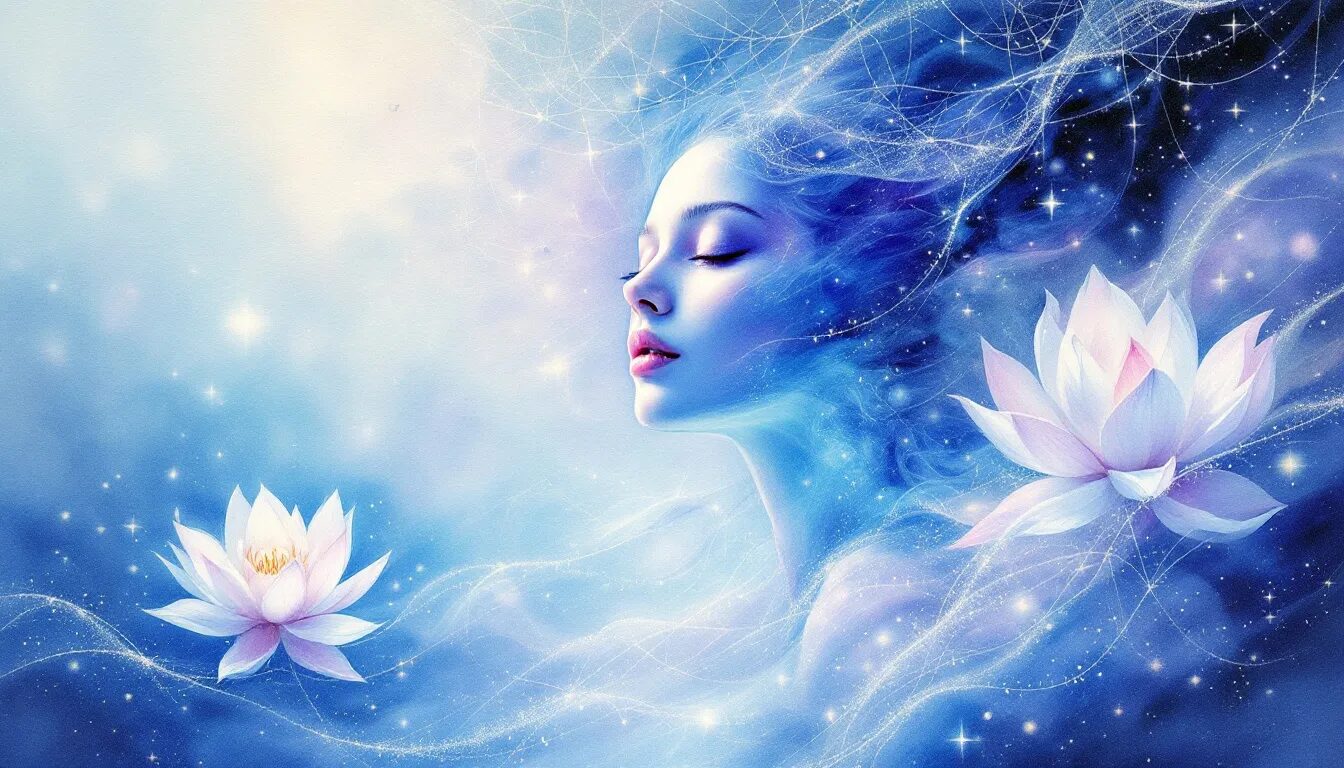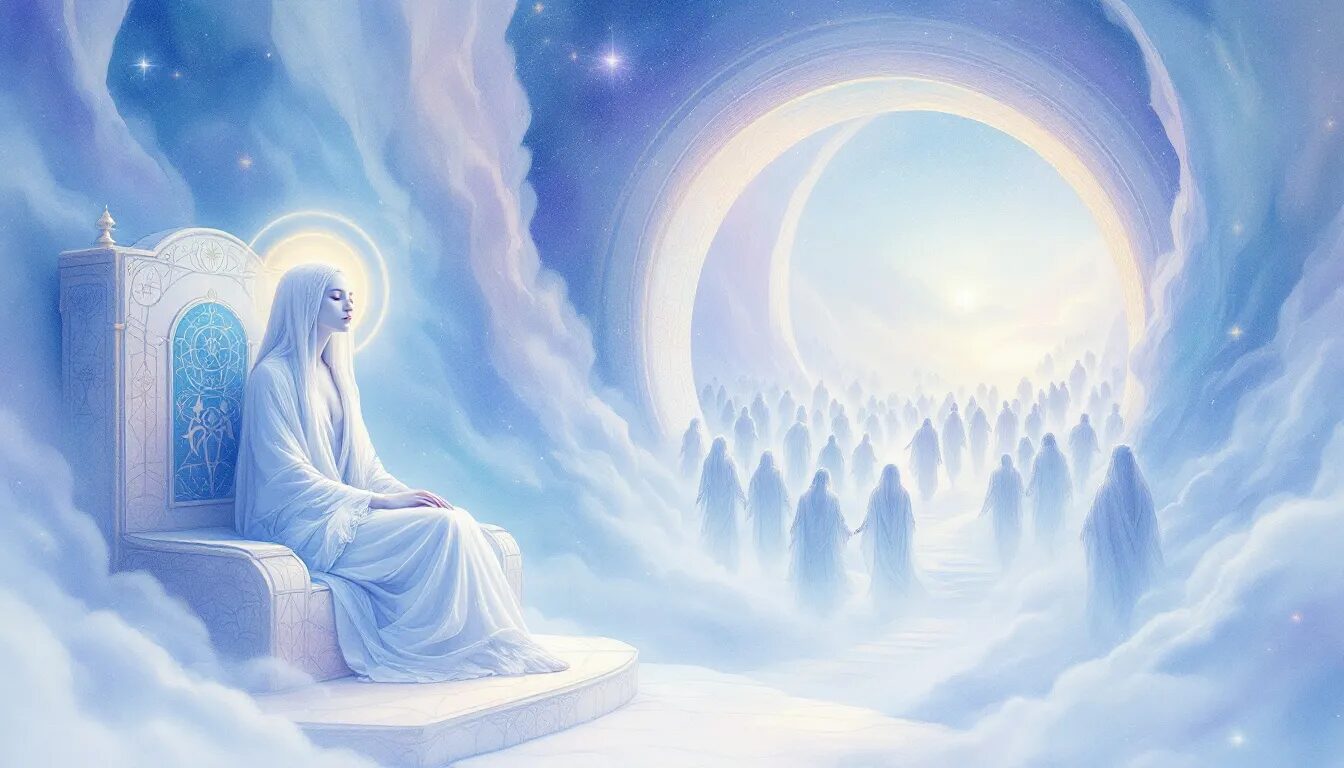What happens after we die? For centuries, this question about the afterlife has intrigued humans. Different cultures and religions offer a variety of beliefs, theories, and perspectives on life beyond death. In this article, we’ll explore these diverse views to understand what the afterlife could mean for us.
Key Takeaways
Beliefs in the afterlife are deeply rooted in human culture, transcending religious and secular boundaries, and providing comfort regarding death.
Ancient civilizations such as the Egyptians and Greeks had intricate beliefs about the afterlife, incorporating elaborate rituals that reflected their cultural identities and moral values.
Contemporary perspectives on the afterlife, including those from modern religious movements and popular culture, reveal a diverse range of interpretations, emphasizing personal experiences and continuous development of the soul.
The Concept of the Afterlife


The belief in an afterlife is a common thread that weaves through the fabric of human culture. Many people hold the view that life continues beyond death, offering a sense of eternal life that transcends the physical body. This belief provides comfort and hope, helping individuals come to terms with the inevitability of death. It is a powerful idea that resonates deeply, whether one is religious or secular, young or old.
Humans have always been curious about what happens after we die. This curiosity is not limited to religious individuals; even in secular societies, the question persists. Children, for instance, often distinguish between biological traits and psychological aspects, reflecting varied perceptions about what happens after death. This innate curiosity drives us to explore and imagine different possibilities, from the existence of a spiritual realm to the concept of reincarnation or even non-existence.
Rituals surrounding death play a crucial role in how we cope with its ambivalence. These rituals help foster a connection with cultural practices and provide a framework for understanding the transition from life to death. The subjective nature of near-death experiences also adds to the complexity of this topic. These experiences can vary widely based on individual cultural and religious backgrounds, influencing their interpretation. Common elements often include feelings of peace and encounters with deceased loved ones, transcending cultural boundaries.
Despite the lack of a universal definition of death, as even scientific communities have yet to reach a complete agreement on this matter, the concept of an afterlife continues to captivate our imagination. Whether we envision a celestial kingdom, a spirit world, or a continued existence in another form, the idea of an afterlife touches on our deepest fears and hopes. It challenges us to consider the essence of life and the possibility of something beyond our earthly existence.
Ancient Beliefs about the Afterlife


Ancient civilizations had elaborate beliefs about the afterlife, reflecting their deep-seated views on death and existence beyond the physical world. These beliefs were integral to their cultural and religious identities, shaping their rituals and practices. Both the ancient Egyptians and Greeks placed significant importance on the afterlife, with elaborate funerary practices and rituals to ensure a successful journey into the next life.
The ancient Egyptians, for example, believed that the afterlife was a continuation of earthly existence. They engaged in elaborate burial rituals, including mummification, to preserve the physical body and ensure the soul’s journey to the afterlife. These practices were not merely ritualistic but were deeply rooted in their belief system, reflecting their understanding of life, death, and the eternal soul.
Similarly, the ancient Greeks and Romans had their own intricate beliefs about the afterlife. They envisioned a journey of the soul, involving passage across the River Styx and judgment in the underworld. This journey and the subsequent judgment determined the soul’s fate, whether it would spend eternity in a place of reward or punishment.
These ancient beliefs offer a fascinating glimpse into how early civilizations understood and coped with the concept of death and what comes after.
Ancient Egyptian Religion
In ancient Egyptian religion, the afterlife was seen as an extension of life on earth. The Egyptians believed that the mummified body was essential for the soul’s existence in the afterlife, as the soul resided within the body. This belief led to the practice of mummification, a complex process that took about seventy days and involved carefully removing internal organs and treating the body to ensure its preservation. The goal was to prepare the deceased for a successful journey and judgment in the afterlife.
One of the most significant aspects of the Egyptian afterlife was the judgment process in the Hall of Ma’at. Here, the heart of the deceased was weighed against the feather of truth to determine their fate. If the heart was found to be lighter than the feather, the soul was granted eternal life in the afterlife. This practice highlights the Egyptians’ belief in moral integrity and the importance of living a righteous life to ensure a favorable outcome in the afterlife.
Ancient Greek and Roman Religions
The ancient Greeks had a vivid and detailed conception of the afterlife, centered around the journey of the soul to the underworld. According to Greek mythology, Charon served as the ferryman who transported souls across the river Styx to the afterlife. This journey was a crucial part of the Greek belief system, reflecting their understanding of death and what lay beyond.
Once the soul crossed the river, it faced judgment and was sent to different realms based on its deeds during life. The virtuous were sent to Elysium, a place of eternal reward, while the wicked were condemned to Tartarus, a realm of punishment. These beliefs highlight the Greeks’ emphasis on moral behavior and the consequences of one’s actions in determining their fate in the afterlife.
Abrahamic Religions and the Afterlife


The Abrahamic religions—Judaism, Christianity, and Islam—share a belief in the continuation of the soul’s existence beyond the physical world. Despite their differences, these religions offer a rich tapestry of ideas about the afterlife, reflecting their core beliefs and teachings. These perspectives provide a sense of hope and purpose, guiding adherents in their moral and ethical decisions.
In Judaism, the concept of the afterlife is less defined compared to Christianity and Islam. Jewish teachings focus more on ethical living in the present life, with the afterlife seen as a process of judgment and cleansing.
Christianity, on the other hand, offers a more detailed description of the afterlife, with the promise of eternal life in Heaven for believers and the threat of Hell for non-believers. Islam shares similar beliefs, emphasizing the judgment of the soul and the destinations of Paradise and Hell based on one’s deeds.
These diverse perspectives highlight the importance of faith, moral behavior, and the hope for a continued existence in a spiritual realm. They offer a framework for understanding life and death, providing comfort and guidance to billions of adherents worldwide.
Jewish Perspectives
In Jewish tradition, the afterlife is conceptualized as a place called Sheol, where souls go after death. Sheol is characterized by a sense of separation from God and the living, reflecting the Jewish understanding of the afterlife as a place of waiting and judgment. The soul undergoes a process of evaluation for its deeds during life, determining its fate in the afterlife.
Within Sheol, souls are believed to reside in different compartments, with the righteous awaiting a favorable outcome and the wicked facing punishment. This belief emphasizes the importance of ethical behavior and moral integrity in Jewish teachings, guiding adherents in their daily lives and decisions.
Christian Views
Christianity offers a detailed and vivid description of the afterlife, centered around the concepts of Heaven and Hell. Upon death, the soul is judged by God, with believers in Jesus Christ promised eternal life in Heaven, while non-believers face eternal damnation in Hell. This judgment is performed by Jesus Christ, who evaluates individuals based on their desires, actions, and choices.
The promise of eternal life in Heaven is a core belief in Christianity, reflecting the infinite love of Jesus Christ and God’s desire for believers to live with Him in the celestial kingdom. This belief is supported by teachings from the New Testament, including letters from Paul, the Gospels, and the Church Fathers.
For those who do not accept salvation and Jesus’s teachings, the consequences are severe. They are condemned to Hell, a place of eternal punishment, emphasizing the importance of repentance and faith in Christian doctrine. These beliefs guide adherents in their moral decisions and provide a framework for understanding life and death.
Islamic Beliefs
Islamic teachings on the afterlife emphasize the continuation of the soul’s existence after physical death. According to Islam, the soul awaits Judgment Day for final assessment, where deeds determine whether one enters Paradise or Hell. This belief reflects the core Islamic teaching that all individuals will face judgment and be held accountable for their actions.
The afterlife in Islam involves a detailed judgment process, where the righteous are granted entry to Paradise, a place of eternal reward, while the wicked are condemned to Hell, a place of eternal punishment. This belief underscores the importance of moral behavior and adherence to Islamic teachings, guiding adherents in their daily lives and decisions.
Near Death Experiences and Research
Near-death experiences (NDEs) offer a fascinating glimpse into the possibility of an afterlife. Studies show that approximately 3.6% to 23% of people who experience cardiac arrest report having an NDE. These experiences often include common elements such as a feeling of peace, encounters with deceased loved ones, and visions of a bright light, transcending cultural and religious boundaries.
Systematic reviews of NDEs have identified four primary categories of experiences: emotional, cognitive, spiritual/religious, and supernatural. These experiences vary widely based on individual cultural and religious backgrounds, influencing their interpretation. While the scientific community continues to debate the nature and significance of NDEs, they offer a compelling insight into the human mind and our understanding of life and death.
Philosophical Perspectives on the Afterlife


Philosophers have long debated the nature of death and the possibility of an afterlife. Many argue that death is not necessarily bad and that the state of being dead should not be considered a negative experience. This perspective challenges the fear of death and encourages a more accepting attitude towards the end of life.
Epicurus, for instance, posited that death itself is annihilation and thus has no effect on the living. His philosophy emphasizes living a fulfilling life focused on minimizing pain and maximizing pleasure, thereby alleviating the fear of death. Similarly, Lucretius argued that the fear of death often stems from an excessive desire for life, which can detract from enjoying the present when a person dies.
These philosophical perspectives offer a different approach to understanding death and the afterlife. They encourage us to focus on living a meaningful and fulfilling life, rather than being consumed by the fear of what comes after. This approach provides a refreshing contrast to religious and cultural beliefs, adding depth to our understanding of this complex topic.
Modern Religious Movements and the Afterlife
Modern religious movements offer diverse and evolving perspectives on the afterlife. Unitarian Universalists, for example, tend to focus on personal experience and reason rather than adhering to a specific doctrine regarding the afterlife. This approach reflects a broader trend towards individual interpretation and personal spirituality in contemporary religious thought.
Wiccans and other modern pagan groups often embrace the belief in reincarnation, viewing life as a cycle of death and rebirth. This belief emphasizes the continuity of the soul’s journey rather than a final destination, reflecting their animistic and interconnected worldview. Contemporary pagan movements also highlight the interconnectedness of all life, both in the present and the afterlife, reinforcing their holistic and nature-focused beliefs.
These modern perspectives on the afterlife illustrate the diversity of human thought and belief. They offer alternative views that challenge traditional doctrines, encouraging dialogue and understanding across different belief systems. This diversity enriches our collective understanding of life, death, and what may lie beyond.
Afterlife in Popular Culture


The concept of the afterlife has found a prominent place in popular culture, often reflecting contemporary societal values and anxieties. Shows like ‘The Good Place’ and ‘Miracle Workers’ portray the afterlife as a bureaucratic system, mirroring the everyday experiences of viewers and adding a humorous twist to the age-old question of what happens when we die. These narratives humanize divine characters, making them more relatable and flawed, in contrast to traditional depictions of God as unchanging and distant.
Modern afterlife narratives often explore themes of eternal love and personal growth, challenging traditional views of commitment and morality. For example, many stories utilize repetition and second chances to illustrate moral development, suggesting that the afterlife is a place for continuous improvement rather than final judgment, where the journey of the immortal soul is emphasized. This approach resonates with contemporary audiences, who are often more focused on personal development and self-improvement.
The enduring fascination with the afterlife in popular culture underscores its universal appeal. These stories tap into our deepest fears and desires, providing a platform for exploring complex ethical and existential questions. Whether through humor, drama, or fantasy, these narratives continue to captivate and inspire, reflecting our ongoing quest to understand the mysteries of life and death.
Conclusion: The Continuing Fascination with the Afterlife
The concept of the afterlife remains a powerful and enduring aspect of human culture. Contemporary portrayals of the afterlife often reflect cultural anxieties and a loss of trust in traditional authorities, highlighting the evolving nature of our beliefs. Understanding life’s big questions and exploring the possibility of an afterlife leads to greater meaning, happiness, and confidence, providing comfort in the face of uncertainty.
These various perspectives, from ancient rituals to modern narratives, underscore the persistent human concern related to the afterlife. They offer a rich tapestry of ideas that continue to shape our cultural and religious practices, guiding us in our moral and ethical decisions.
As we navigate the complexities of life and death, the concept of the afterlife remains a source of hope, comfort, and inspiration, reflecting our deepest fears and highest aspirations.
Summary
In summary, the belief in an afterlife is a common and deeply rooted aspect of human culture. From the elaborate rituals of ancient Egyptians to the philosophical musings of Epicurus, these beliefs provide comfort, meaning, and guidance in our lives. The Abrahamic religions offer detailed doctrines on the afterlife, emphasizing judgment and moral behavior, while modern religious movements and popular culture provide diverse and evolving perspectives.
The ongoing fascination with the afterlife reflects our innate curiosity and desire for understanding. These beliefs and narratives help us cope with the inevitability of death, offering hope and a sense of continued existence. As we continue to explore and imagine what lies beyond, the concept of the afterlife will remain a vital and enduring part of the human experience.
Frequently Asked Questions
What do ancient Egyptians believe about the afterlife?
Ancient Egyptians believed in a continuation of earthly existence, emphasizing the need for elaborate burial rituals and mummification to facilitate the soul’s journey and ensure successful judgment in the afterlife.
How do the Abrahamic religions view the afterlife?
The Abrahamic religions uphold a belief in the soul’s existence after death, although they differ significantly in their views on judgment, Heaven, and Hell. Each tradition offers unique insights into the afterlife that reflect their distinct theological foundations.
What are near-death experiences (NDEs)?
Near-death experiences (NDEs) typically involve profound feelings of peace, encounters with deceased individuals, and visions of bright light reported by those who have been close to death. These experiences often leave a lasting impact on individuals, shaping their perceptions of life and existence.
How do modern religious movements view the afterlife?
Modern religious movements, such as Unitarian Universalism and Wicca, often emphasize personal experience, with beliefs varying from a focus on reason to concepts like reincarnation and the interconnectedness of all life. This reflects a diverse understanding of the afterlife that prioritizes individual interpretation and experience.
How is the afterlife depicted in popular culture?
The afterlife in popular culture is often depicted as a bureaucratic system, as seen in shows like ‘The Good Place’ and ‘Miracle Workers,’ which humanize divine figures and delve into themes of love and personal growth. This portrayal invites viewers to reflect on moral and existential questions.
The Afterlife: Beliefs, Theories, and Perspectives
This gripping episode uncovers the eerie tale of King Saul and the Witch of Endor—the Bible’s only recorded séance. Dive into the historical context, ancient laws on necromancy, afterlife and the dramatic consequences of summoning the prophet Samuel. A must-watch for fans of the supernatural, faith, and the mysteries of life beyond death.
Subscribe now to EXORCISTA: Secrets, Spells, and Shadows and never miss what hides behind the veil.











